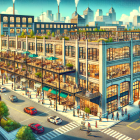Imagine walking into a trendy new office space, only to find out it was once an abandoned warehouse from the 1920s! That’s the magic of adaptive reuse in commercial properties. Did you know that adaptive reuse projects can reduce construction costs by up to 16% compared to new builds? It’s not just about saving money though – it’s about creating something extraordinary from the old and forgotten. In this article, we’ll explore how adaptive reuse is revolutionizing the commercial real estate landscape, one building at a time!
What is Adaptive Reuse in Commercial Real Estate?
Have you ever walked past an old factory or warehouse and thought, “Wow, that would make an amazing office space or trendy restaurant”? Well, that’s the essence of adaptive reuse in commercial real estate! It’s all about taking existing buildings and giving them a new lease on life by repurposing them for different uses.
This concept isn’t new, though. In fact, people have been adapting buildings for centuries. Think about all those medieval castles that are now museums or hotels. But in recent years, adaptive reuse has really taken off in the commercial real estate world.
Why? Well, there are tons of benefits! For one, it’s a great way to preserve historical architecture and the character of neighborhoods. Plus, it can be a real money-saver compared to building from scratch. And let’s not forget the cool factor – who wouldn’t want to work in a converted fire station or dine in a former bank vault?
Some fantastic examples of adaptive reuse include the Tate Modern in London (a former power station turned art gallery) and the High Line in New York City (an abandoned elevated railway transformed into a public park). These projects show just how creative and impactful adaptive reuse can be.
The Environmental Impact of Adaptive Reuse
Now, let’s talk about the environment. We all know construction can be pretty rough on Mother Nature, right? Well, adaptive reuse is like a superhero swooping in to save the day!
First off, it dramatically reduces construction waste. Instead of demolishing an entire building and sending all that material to landfills, we’re working with what’s already there. It’s like the ultimate recycling project!
Energy savings are another big win. Building new structures from the ground up requires a ton of energy, from manufacturing materials to transportation and construction. Adaptive reuse skips a lot of that, making it a much greener option.
There’s also this cool concept called “embodied energy.” It’s all the energy that went into creating the original building – from extracting raw materials to manufacturing and construction. When we reuse a building, we’re preserving all that embodied energy instead of wasting it.
In the bigger picture, adaptive reuse plays a crucial role in sustainable urban development. It helps revitalize neighborhoods without expanding the city’s footprint, which is a win-win for everyone.
Economic Advantages of Adaptive Reuse for Businesses
Let’s talk money, honey! Adaptive reuse can be a real boon for businesses looking to save some cash while getting unique spaces.
Construction and renovation costs are often lower with adaptive reuse compared to new construction. You’re working with an existing structure, so you’re not starting from scratch. Plus, many cities offer tax incentives and grants for adaptive reuse projects, especially if you’re preserving a historic building. Cha-ching!
But it’s not just about saving money – it’s about making money too. Adaptive reuse projects often come with built-in marketing opportunities. Imagine the story you can tell about your business operating in a converted 1920s cinema or a former post office. It’s instant brand appeal!
And let’s not forget about attracting tenants and customers. People love unique spaces with character. A cookie-cutter office building? Yawn. A renovated industrial loft with exposed brick and soaring ceilings? Now we’re talking!
Challenges and Considerations in Adaptive Reuse Projects
Okay, let’s get real for a minute. As amazing as adaptive reuse can be, it’s not always a walk in the park. There are some challenges you need to keep in mind.
First up, structural and safety concerns. Old buildings can have hidden issues that only become apparent once you start renovating. Asbestos, anyone? Not fun, but definitely something you need to watch out for.
Then there’s the whole zoning and building code compliance thing. Laws change over time, and what was perfectly fine 50 years ago might not fly today. You might need to do some serious upgrades to meet current standards.
Balancing modern needs with historical preservation can also be tricky. How do you add air conditioning to a 19th-century building without ruining its charm? It’s a delicate dance, for sure.
And let’s not forget about the potential for unexpected costs and delays. Renovating old buildings can be like opening Pandora’s box – you never know what you’re going to find once you start tearing down walls!
Best Practices for Successful Adaptive Reuse
Now that we’ve scared you a bit with the challenges, let’s talk about how to make adaptive reuse projects successful.
First and foremost, do your homework! A thorough building assessment and feasibility study are crucial. You need to know exactly what you’re getting into before you start.
Next, assemble your dream team. Working with experienced architects and contractors who understand the ins and outs of adaptive reuse can make all the difference.
Don’t forget to engage with the local community and preservation groups. They can be your biggest allies or your biggest headaches, depending on how you approach them. Get them on board early!
Lastly, think green. Incorporating sustainable design principles not only helps the environment but can also save you money in the long run. Win-win!
The Future of Adaptive Reuse in Commercial Real Estate
So, what’s next for adaptive reuse? The future looks bright, my friends!
We’re seeing some exciting trends emerging. For example, more and more tech companies are setting up shop in converted industrial spaces. It’s all about that cool, creative vibe.
Technology is also playing a big role. Innovations like 3D scanning and Building Information Modeling (BIM) are making it easier to plan and execute adaptive reuse projects.
Post-pandemic, there’s a huge opportunity for adaptive reuse in office spaces. With so many companies downsizing or going remote, there’s a lot of empty office space ripe for transformation.
And let’s not forget about smart cities. As urban areas evolve, adaptive reuse will play a crucial role in creating more sustainable, efficient, and livable cities.
The bottom line? Adaptive reuse isn’t just a trend – it’s the future of sustainable, innovative commercial real estate. So next time you pass that old, abandoned building, don’t just see what it is – imagine what it could be!
Conclusion
Adaptive reuse of commercial properties isn’t just a trend – it’s a smart, sustainable, and creative approach to real estate development. By breathing new life into old buildings, we’re not only preserving our architectural heritage but also creating unique, character-filled spaces for modern businesses to thrive. Whether you’re a property developer, business owner, or simply someone who appreciates innovative design, adaptive reuse offers exciting possibilities for the future of our urban landscapes. So, the next time you pass by an old, abandoned building, don’t just see it for what it is – imagine what it could become!





